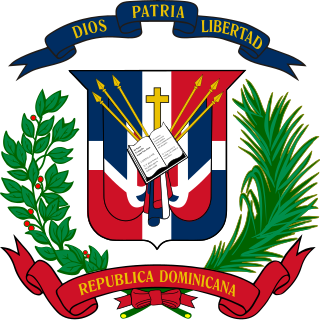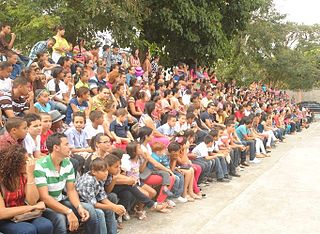
The Dominican Republic is a country located on the island of Hispaniola in the Greater Antilles archipelago of the Caribbean region. It occupies the eastern five-eighths of the island, which it shares with Haiti, making Hispaniola one of only two Caribbean islands, along with Saint Martin, that are shared by two sovereign states. The Dominican Republic is the second-largest nation in the Antilles by area at 48,671 square kilometers (18,792 sq mi), and third-largest by population, with approximately 10.8 million people, of whom approximately 3.3 million live in the metropolitan area of Santo Domingo, the capital city. The official language of the country is Spanish.

The foreign relations of the Dominican Republic are the Dominican Republic's relations with other governments.

Hispaniola is an island in the Caribbean that is part of the Greater Antilles. Hispaniola is the most populous island in the West Indies, and the region's second largest in area, after the main island of Cuba.

Santo Domingo, once known as Santo Domingo de Guzmán, is the capital and largest city of the Dominican Republic and the largest metropolitan area in the Caribbean by population. As of 2010, the city had a total population of 2,908,607, when including the metropolitan area. The city is coterminous with the boundaries of the Distrito Nacional, itself bordered on three sides by Santo Domingo Province.

Dominicans are people of the Dominican Republic. This identification may be historical, cultural, legal, or residential. For most Dominicans, several of these connections exist and are collectively the source of being Dominican.

The flag of the Dominican Republic represents the Dominican Republic and, together with the coat of arms and the national anthem, has the status of a national symbol. The blue on the flag stands for liberty, the white for salvation, and the red for the blood of heroes. The civil ensign follows the same design, but without the charge in the center. The flag was designed by Juan Pablo Duarte.

The culture of the Dominican Republic is a diverse mixture of different influences from around the world. The Dominican people and their customs have origins consisting predominately in a European cultural basis, with both African and native Taíno influences.

Félix Sánchez, is a retired Dominican-American track and field athlete. He is of Dominican descent, was born and raised in the United States, and competed for the Dominican Republic, specializing in the 400 meter hurdles. He is a two-time Olympic gold medallist, winning gold in 2004 and 2012, and was also World Champion in 2001 and 2003. Just before turning 36, he set the Masters M35 World Record with a time of 48.10. Sanchez acquired many nicknames: "Super Felix", "the Invincible", "Superman", and "the Dictator".
The Dominican Republic national football team represents the Dominican Republic in men's international football, and is governed by the Dominican Football Federation. The team is a member of the Caribbean Football Union of CONCACAF, the governing body of football in North and Central America and the Caribbean. The Dominican Republic has never qualified for the FIFA World Cup finals.

The 14th Pan American Games were held in Santo Domingo, Dominican Republic, from August 1 to 17, 2003. The successful bid for the games was made in the mid-1990s, when Dominican Republic had one of the highest growth rates in Latin America.

The Dominican Republic Professional Baseball League or LIDOM by its acronym in Spanish, is a winter professional baseball league consisting of six teams spread across the Dominican Republic; it is the highest level of professional baseball league in the Dominican Republic. The league's players include many prospects that go on to play in Major League Baseball in the United States while also signing many current MLB veterans. The champion of LIDOM advances to play in the yearly Caribbean Series.

The parsley massacre was a mass killing of Haitians living in the Dominican Republic's northwestern frontier and in certain parts of the contiguous Cibao region in October 1937. Dominican Army troops came from different areas of the country and carried out the massacre on the orders of Dominican dictator Rafael Trujillo. As a result of the massacre, virtually the entire Haitian population in the Dominican frontier was either killed or forced to flee across the border.

The first Jews known to have reached the island of Hispaniola were Sephardi Jews who came from the Iberian Peninsula during the colonization era in the 1490s.

The Dominican Republic national basketball team represents the Dominican Republic in men's international basketball competitions. In 2011 and 2012, John Calipari, the head coach of the University of Kentucky men's basketball team, served as the head coach of the team. The team placed third in the 2011 FIBA Americas Championship and fourth in the 2012 FIBA World Olympic Qualifying Tournament, one position shy of qualifying for the 2012 Olympics.

The Dominican Republic competed in the 2008 Summer Olympics, held in Beijing, People's Republic of China from August 8 to August 24, 2008.
Sports are a central part of the culture of the Dominican Republic, and have been practiced in the whole country since the native inhabitants were living in the island. Sports play a key role in the culture and makeup of Dominican Republic society. Baseball is the most popular sport on the island country and Major League Baseball has been recruiting players from the Dominican Republic since the 1960s. Association football is the second sport of the country.

The Dominican Republic competed at the 2012 Summer Olympics in London, United Kingdom, from 27 July to 12 August 2012. This was the nation's thirteenth consecutive appearance at the Olympics.

Dominican Republic competed at the 2014 Summer Youth Olympics, in Nanjing, China from 16 August to 28 August 2014.

Dominican Republic competed at the 2016 Summer Olympics in Rio de Janeiro, Brazil, from 5 to 21 August 2016. This was the nation's fourteenth consecutive appearance at the Summer Olympics.

The Dominican Republic–Haiti border is the international boundary between the Dominican Republic (DR) and Haiti. The border is 376 km in length and divides the island of Hispaniola in two by the Treaty of Ryswick which was signed by the two former European colonial masters of the respective countries, France and Spain. In 1621, England made an unsuccessful attempt to take over both sides of the island. In the early 20th century, the United States occupied both countries, and made numerous changes to the border. The Dominican Republic comprises approximately the Eastern two-thirds of the island and Haiti the Western third.













